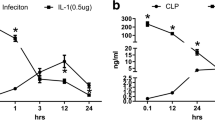Abstract
Pretreatment with recombinant human interleukin-1β (IL-1) protected normal BALB/c mice from the lethal effect adriamycin (ADM) of related to dose and frequency of administration. Posttreatment with IL-1 failed to protect. Neutrophil and platelet counts after the administration of ADM (16mg/kg) did not differ between the group with and that without IL-1 pretreatment, whereas lipid peroxide levels in the heart were reduced in the group pretreated with IL-1. It appears that the chemoprotection mechanism of IL-1 lies in the prevention of cardiotoxicity due to ADM-induced free radicals.
Similar content being viewed by others
Abbreviations
- IL-1:
-
interleukin-1
- ADM:
-
adriamycin
- MDA:
-
malondialdehyde
- MnSOD:
-
manganous superoxide dismutase
References
Lenaz L, Page JA. Cardiotoxicity of Adriamycin and related anthracycline. Cancer Treat Rev, 1976; 3:111–20.
Buzdar AU, Marcus C, Smith TL, Blumenschein GR. Early and delayed clinical cardiotoxicity of doxorubicin. Cancer 1985; 55:2761–5.
Lefrak EA, Pitha J, Rosenheim S, Gottlieb JA. A clinicopathologic analysis of adriamycin cardiotoxicity. Cancer 1973; 32:302–14.
Henderson IC, Frei E. Adriamycin cardiotoxicity. Am Heart J. 1980; 99: 671–4.
Ahmed NK, Felsted RL, Bachur NR. Heterogeneity aldo-keto reductase. Fed Proc 1977; 36:723–6.
Mimnaugh EG, Truth MA, Bhatnagar M, Gram TE. Enhancement of reactive oxigen-dependent mitochondrial membrane lipid peroxidation by the anticancer drug adriamycin. Biochem Pharmacol 1985; 34:847–56.
Caroni P, Villani F, Carafoli E. The cardiotoxic antibiotic doxorubicin inhibits the Na+/Ca2+ exchange of dog heart sarcolemnal vesicles. FEBS Letters 1981; 130:184–6.
Nachtman JP, Roginski ET, Banning JW, Wormser HC, Abramson HC, and Corbett TH. DNA binding, cardiac superoxide production and cytotoxicity of daunomycin analog. Res. Commun. Chem. Phathol Pharmacol 1985: 47:73–8.
Myers CE. Adriamycin: the role of lipid peroxidation in cardiac toxicity and tumor response. Science 1977; 197:165–7.
Wang YM, Madanat FF, Kimball JC, Gleiser CA, Ali MK, Kaufman MW, Eys JV. Effect of Vitamin E against adriamycininduced toxicity in rabbits. Cancer Res 1980; 40;1022–7.
McCord JM, Freidovich I. Superoxide dismutase. An enzymic function for erythrocuprein. J Biol Chem 1969; 244:6049–55.
Masuda A, Longo DL. Kobayashi Y, Appella E, Oppenheim JJ, Matsushima K. Induction of mitochondrial manganese superoxide dismutase by interleukin 1. FASEB 1988; 2:3087–91.
Wong GHW, Goeddel DV. Induction of manganous superoxide dismutase by tumor necrosis factor: Possible protective mechanism. Science 1988; 242:941–4.
Nishida M, Nishino N, Takano N, Kawai K, Bando K. Masui Y, Nakai S, Hirai Y. cDNA cloning of IL-1 beta from mRNA of U937 cell line. Biochem Biophys Res Commun 1987; 143:345–52.
Ohkawa H, Ohnishi N, Yagi K. Assay for lipid peroxides in animal tissues by thiobarbituric acid reaction. Anal Biochem 1979; 95:351–8.
Neta R., Douches S, Oppenheim JJ. Interleukin 1 is a radioprotector. J Immunol 1986; 136:2483–5.
Yamanaka N, Kato T, Nishida K, Fujikawa T. Fukushima M. Ota K. Elevation of serum lipid peroxide level associated with doxorubicin toxicity and its amelioration by [dl]-a-tocopheryl acetate or coenzyme Q 10 in mouse. Cancer chemother pharmacol 1979; 3: 223–7.
Neta R, Sztein MB, Oppenheim JJ, Gillis S, Douches SD. The in vivo effect of interleukin 1. J Immunol 1987; 139: 1861–6.
Moore MAS, Warren DJ. Synergy of interleukin 1 and granulocyte colony-stimulating factor: in vivo stimulation of stermcell recovery and hematopoietic regeneration following 5-fluorouracil treatment of mice. Proc Natl Acad Sci USA 1987; 84:7134-.
Hutami H, Jansen R, Macphee MJ, Keller J, McCormick K, Longo DL, Oppenheim JJ, Ruscetti FW, Wiltrout RH. 1990. Chemoprotective effects of recombinant human IL-1α in cyclophosphamide-treated normal and tumor-bearing mice. J Immunol 1990; 145: 4121–30.
Marcillat O, Zhang Y. Davies KJA. Oxidative and non-oxidative mechanisms in the inactivation of cardiac mitochondral electron transport chain components by doxorubicin. Biochem J 1989: 259: 181–9.
Griffin-Green EA, Zaleska MM, Erecinska M. Adriamycininduced lipid peroxidation in mitochondria and microsomes. Biochem Pharm 1988; 37: 3071–7.
Usui N, Mimnaogh EG. Sinha BK. A role for the interleukin 1 receptor in the synergistic antitumor effects of human interleukin 1α and etoposide against human melanoma cells. Cancer Research 1991; 51:769–74.
Kilian PL, Kaffka KL, Biondi DA, Lipman JM. Benjamin WR, Feldman D, Campen CA. Antiproliferative effect of interleukin-1 on human ovarian carcinoma cell line (NIH:OVCAR-3). Cancer Reseach 1991; 51: 1823–8.
Onozaki K., Matsushima K., Kleinerman ES, Saito T, Oppenheim JJ. Role of interleukin 1 in promoting human monocytemediated tumor cytotoxicity. J Immunol 1985:135:314–20.
Ido M., M. Harada M, Furuichi H, Matsuoka N, Nakano K, Sohmura Y. Interleukin 1-induced sequential myelorestoration: dynamic relation between granulopoiesis and progenitor cell recovery in myelosuppressed mice. Exp Hematol 1992; 20:161–6.
Yoshida T, Okumra H, Kaya H. Okabe Y, Matano S, Ohtake S, Nakamura S, Matsuda T. Prevention of doxorubicin-induced cardiotoxicity by recombinant interleukin-1 in hamsters. Biotherapy 6: 125–132, 1993.
Author information
Authors and Affiliations
Rights and permissions
About this article
Cite this article
Okumura, H., Yoshida, T., Kaya, H. et al. A recombinant human interleukin-1β protects adriamycin-induced toxicity. Biotherapy 7, 137–143 (1993). https://doi.org/10.1007/BF01877737
Received:
Accepted:
Issue Date:
DOI: https://doi.org/10.1007/BF01877737




